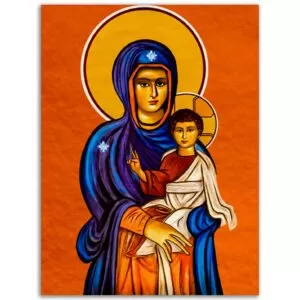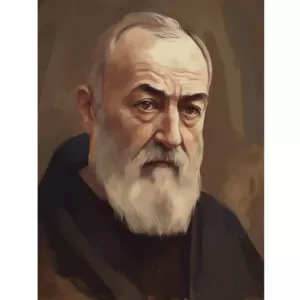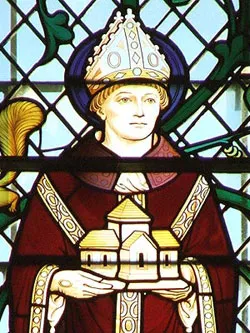SAINT EPHREM

SAINT EPHREM
The primary vocation of St. Ephrem was to be a teacher. Immediately after his conversion to Christianity at the age of 18 he placed himself under the tutelage of the local bishop, St. James of Nisibis, a city in Upper Mesopotamia. St. James accepted Ephrem as a pupil into his household and gave him an excellent education in Biblical studies.
The last, and most fruitful, decade of Ephrem’s life was passed in Edessa, the modern
Urfa, a city which not only enjoyed great material prosperity thanks to its thriving
armament industry, but one which was also a vital center of Christian asceticism. Ephrem,
upon his arrival here as a poor and unknown exile, resolved to follow the example of the
apostles by living from the work of his hands. He therefore became an employee at the
public baths, and during his free time engaged in public disputes with the infidels, to
whom he preached the glories of the Christian faith. One day, not long after his arrival
at Edessa, a hermit from the neighboring countryside chanced to overhear one of Ephrem’s
discourses, and, deeply impressed by his learning and his piety, besought Ephrem to follow
him into the desert. Ephrem accordingly established himself in a cave in the hills above
the city, where he proceeded to write a series of commentaries on the books of the Old
Testament. These he intended to publish anonymously upon their completion, but his
manuscript was stolen from him and circulated about the city. Before long, great crowds of
admirers began to come out in search of Ephrem. His first impulse was to flee, but as he
prepared to depart, an angel admonished him not to hide his light under a bushel. Ephrem,
therefore, consented to return to the city, and quickly became head of the Schola
Persarum, an episcopal school for Chistian refugees similar to that which he had conducted
at Nisibis.
During the last year of his life, St. Ephrem labored in the city of Edessa to alleviate
the effects of a severe famine. He was charged with the distribution of alms to the poor
and with the organization of medical and other assistance to those in need. After the
spring harvests had been gathered in, St. Ephrem considered his mission accomplished and
retired for the last time to his cave outside the city. There he died, aged about 70, in
June 373, the same year that winessed the passing of St. Athanasius.
St. Ephrem’s esteem for simple, childlike faith is nowhere better illustrated than in
his sequence of seven hymns on the Pearl. The Syrian term for “word” being the
same as that which means “pearl,” these poems celebrate Christ, the Eternal Word
of God, as well as the virtue of faith, the “pearl of great price.” In its
silent discourse, the Pearl instructs St. Ephrem on the limitations of the human
intellect. “I am the daughter of the immense sea,” it declares; “I bear,
enclosed in my bosom, a treasure, – the treasure of the secrets of the Ocean which
engendered me. As for you, abide in the waters which it was given you to abide in; respect
your Lord; do not try to sound the Ocean of the Godhead.” The Pearl, in its
mysterious and immaculate origin, represents the double generation of Christ in the bosom
of the Father and in the womb of the Virgin Mary. In contemplating the Pearl, the poet is
enlightened concerning numerous other mysteries of faith; “The brilliance of the
Pearl and its unequalled splendor represented for me the superior nature (of the Son of
God), whose brightness is not veiled by any shadow, and whose peace is troubled by no war.
Its marvelous whiteness was also for me a symbol of the most pure body of the Lord; its
nature, one and indivisible, testified that truth, likewise, is one. Yes, I beheld in it
the image of the Church…”
St.Ephrem, deeply appreciative of the honor conferred upon human flesh by the
Incarnation, makes no secret of his impatience with those who seek to undermine the
doctrine of the hypostatic union. In language similar to that which St. Cyril of
Alexandria was to use against the Nestorians in the following century, he insists on the
intimate marriage of the human and divine natures in the Person of Jesus.
“Praiseworthy and wise is He Who united and mixed the divinity and the humanity. The
two natures, one from on high and the other from below, he mixed as do pharmacists, and
became the God-man.” “He was one in divinity and humanity without distinction.
Believe that our humanity was spiritual in Him Who clothed Himself with a body, and that
He is not two but one, from the Father and from Mary. He who divides Him in two will not
enjoy Eden with Him.” St. Ephrem’s choice of words, however, was such as would give
comfort to the Monophysites, who in a later generation attempted to deny the distinctness
of the human and divine natures in Christ. “That one,” writes St. Ephrem,
“who was present in these circumstances was not one but rather two. There was not
present only the humble nature, nor only the sublime, but two were the natures, of which
one was mixed with the other, the sublime with the inferior. Therefore these two natures
expressed their own thoughts, so that by the thoughts of two, men might perceive that they
were two.”
Because of his loving comprehension of the mystery of the Incarnation, St. Ephrem was
prompt in recognizing the unique honor which pertains to Mary as the Mother of God. With
great tenderness and delicacy he dramatized, in dialogues which foreshadow the mystery
plays of the middle ages, the beautiful role played by Our Lady in the joyous events at
Bethlehem and later at the foot of the Cross on Calvary. Observe with what gracious
humility, in one of these dramas, Mary addresses the Magi who have come from the East to
adore the Son of God: “My son has no armies,” she says, “not legions, nor
cohorts. He lies there in his mother’s poverty, and you call him King!” To which the
Magi reply, with a magnificent profession of faith, “The armies of your son are on
high. His knights move about the heavens as stars of fire.”
rosary.team
















